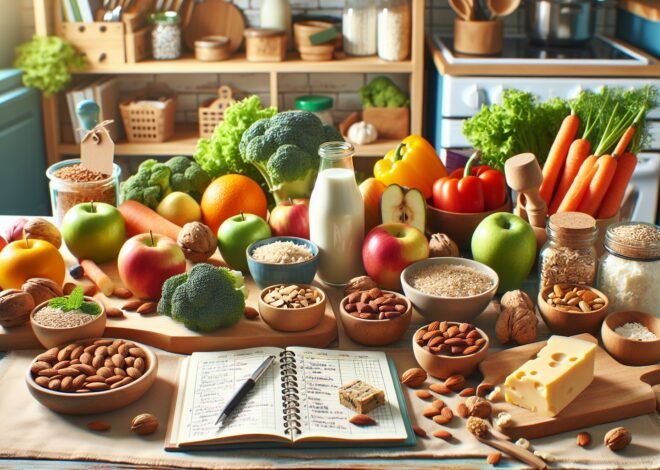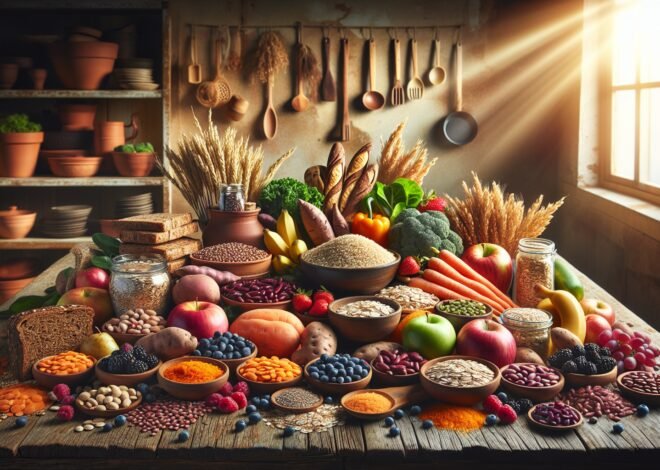
How to Include More Fruits and Vegetables in a Balanced Diet
Fruits and vegetables in diet are critical for maintaining overall health and wellness. Despite their importance, many people struggle to consume the recommended daily servings. According to the World Health Organization, insufficient intake of fruits and vegetables is linked to numerous health issues. This post will explore practical strategies to seamlessly incorporate more fruits and vegetables into your balanced diet, enhancing nutrition. By making smaller, sustainable changes, you can transform your eating habits. Discover versatile tips that cater to busy lifestyles, making it easier to boost your nutrient intake daily.
Why Eating More Fruits and Vegetables is Beneficial
Incorporating a variety of fruits and vegetables into your diet can transform your health significantly. They are packed with essential nutrients and provide numerous health benefits. Let’s explore the unique advantages they offer, including boosting nutritional intake, enhancing immune function, and aiding in weight management.
Nutritional Advantages of Fruits and Vegetables
Fruits and vegetables are nutritional powerhouses. They’re rich in vitamins, minerals, and antioxidants that are crucial for maintaining good health. For instance, citrus fruits and berries are high in vitamin C, which is vital for collagen production and skin health. Leafy greens like spinach and kale offer a good dose of vitamin K, important for bone health.
- Fiber Content: High fiber content in fruits and vegetables aids digestion and maintains bowel health. It also helps in controlling blood sugar levels and lowering cholesterol.
- Antioxidants: The antioxidants found in these foods help protect cells from damage caused by free radicals, potentially lowering the risk of chronic diseases.
- Hydration: Many fruits and vegetables, such as cucumbers and watermelon, have high water content, contributing to your daily hydration needs.
How Fruits and Vegetables Support Immune Health
A robust immune system is essential for warding off illnesses and infections. Fruits and vegetables play a crucial role in supporting immune health by providing essential vitamins and nutrients.
- Vitamin C and E: These vitamins are known to boost the immune system by stimulating the production of white blood cells. Oranges, strawberries, and almonds are excellent sources.
- Beta-Carotene: Found in carrots and sweet potatoes, beta-carotene is converted into vitamin A, which is essential for maintaining the integrity of the skin and mucous membranes, acting as the body’s first line of defense.
- Zinc and Selenium: These minerals, found in mushrooms and spinach, help in developing immune cells and regulating inflammation.
Impact of Fruits and Vegetables on Weight Management
Maintaining a healthy weight is critical for reducing the risk of various health issues. Fruits and vegetables can be highly effective in weight management due to their low-calorie density and high fiber content.
- Low-Calorie Density: Fruits and vegetables are naturally low in calories, allowing you to consume larger portions without exceeding your daily caloric intake.
- Satiety: The fiber in fruits and vegetables increases feelings of fullness, reducing overall calorie consumption and helping with weight loss.
- Natural Sweetness: They offer a healthier alternative to sugary snacks, helping to curb sweet cravings with natural sugars like those found in apples and grapes.
Easy Ways to Add More Fruits and Vegetables to Your Diet
Incorporating more fruits and vegetables into your diet doesn’t have to be a daunting task. With a little creativity and planning, you can easily increase your intake. From crafting innovative meals to snacking smartly, there are numerous ways to enjoy the benefits of fresh produce.
Creative Meal Planning with Fruits and Vegetables
Planning meals can be both fun and rewarding when you include a variety of fruits and vegetables. Here are some ideas to inspire you:
- Breakfast Smoothies: Blend a variety of fruits and greens like spinach or kale for a nutritious start to your day.
- Salad Variations: Experiment with different combinations of greens, fruits like strawberries or oranges, and nuts for a satisfying salad.
- Veggie-Packed Soups: Use seasonal vegetables to create hearty soups that are both filling and nutritious.
Snacking on Fresh Produce Throughout the Day
Snacking on fresh produce is an excellent way to keep your energy levels up while avoiding unhealthy options. Here are some easy ideas:
- Fruit Kabobs: Skewer a selection of fresh fruits like pineapple, grapes, and melons for a refreshing snack.
- Veggie Sticks: Carrots, cucumbers, and bell peppers make excellent snacks when paired with hummus or a low-fat dip.
- Apple Slices with Peanut Butter: A classic combination that’s both satisfying and nutritious.
Incorporating Fruits and Vegetables into Recipes
Integrating fruits and vegetables into your meals can enhance flavor and nutritional value. Consider these approaches:
- Add to Pasta Dishes: Mix in vegetables like zucchini, cherry tomatoes, and spinach for a healthier pasta.
- Fruit-Infused Desserts: Use fruits like berries or bananas in desserts to add natural sweetness and cut down on sugar.
- Stuffed Vegetables: Try stuffed bell peppers or zucchinis with grains and veggies for a delicious main course.
Tips for Buying and Storing Fruits and Vegetables
Knowing how to select and store fruits and vegetables can help you enjoy them at their peak freshness and save money. Here are some tips for ensuring you get the best quality produce and keep it fresh.
Choosing Seasonal Produce for Better Nutrition
Buying seasonal produce not only enhances flavor but also boosts nutritional value. Fruits and vegetables in season are often fresher and more nutrient-dense.
- Spring: Look for asparagus, peas, and strawberries.
- Summer: Opt for tomatoes, peaches, and berries.
- Fall: Apples, pumpkins, and carrots are at their best.
- Winter: Enjoy root vegetables like turnips, squash, and citrus fruits.
How to Properly Store Fruits and Vegetables at Home
Proper storage can extend the life of your produce and maintain its nutritional quality. Here are some storage tips:
- Refrigeration: Keep leafy greens, berries, and apples in the fridge to preserve freshness.
- Room Temperature: Store bananas, tomatoes, and onions at room temperature to avoid losing flavor and texture.
- Separate Ethylene Producers: Certain fruits like bananas and avocados produce ethylene gas, which can speed up ripening. Store them away from sensitive items.
Budget-Friendly Tips for Buying Fresh Produce
Fresh produce doesn’t have to break the bank. Here are some strategies to get the best value for your money:
- Buy in Bulk: Purchase bulk quantities of long-lasting items like potatoes and onions.
- Shop Local: Farmers’ markets often offer fresher produce at competitive prices.
- Frozen Options: Don’t overlook frozen fruits and vegetables, as they are often picked at peak ripeness and are equally nutritious.
By following these tips and strategies, you can easily reap the benefits of fruits and vegetables, improving your health and well-being.
Conclusion
Incorporating fruits and vegetables into the diet is crucial for optimal health. They provide essential vitamins, minerals, and fiber that support bodily functions and prevent disease. A diet rich in fruits and vegetables can reduce the risk of chronic illnesses like heart disease and cancer. It’s recommended to consume a variety of colors and types to ensure a range of nutrients. Fresh, frozen, and canned options can all be part of a healthy diet.
FAQ
What are the health benefits of including fruits and vegetables in your diet?
Fruits and vegetables are packed with essential nutrients like vitamins, minerals, and antioxidants. They boost immune function, improve digestion, and lower the risk of chronic diseases. These foods also support healthy skin and increase energy levels.
How many servings of fruits and vegetables should I eat daily for optimal health?
Health experts recommend eating at least five servings of fruits and vegetables daily. This helps to ensure you get a variety of nutrients and fibers essential for maintaining overall health.
Which fruits and vegetables are best for weight loss?
To aid weight loss, focus on low-calorie and fiber-rich options like berries, apples, leafy greens, and cruciferous vegetables. These foods keep you full longer and help control appetite.
Are frozen fruits and vegetables as nutritious as fresh ones?
Frozen fruits and vegetables retain most of their nutrients, making them a convenient and nutritious choice. They are often frozen at peak ripeness, preserving their vitamins and minerals.
What are some easy ways to incorporate more fruits and vegetables into meals?
Add fruit to your breakfast cereal or yogurt, snack on raw veggies, or blend them into smoothies. Including vegetables in soups, stews, and stir-fries can also boost your intake effortlessly.
How do fruits and vegetables contribute to heart health?
Rich in fiber, vitamins, and antioxidants, fruits and vegetables help lower blood pressure and reduce cholesterol levels. Their anti-inflammatory properties support heart health and reduce the risk of cardiovascular diseases.











